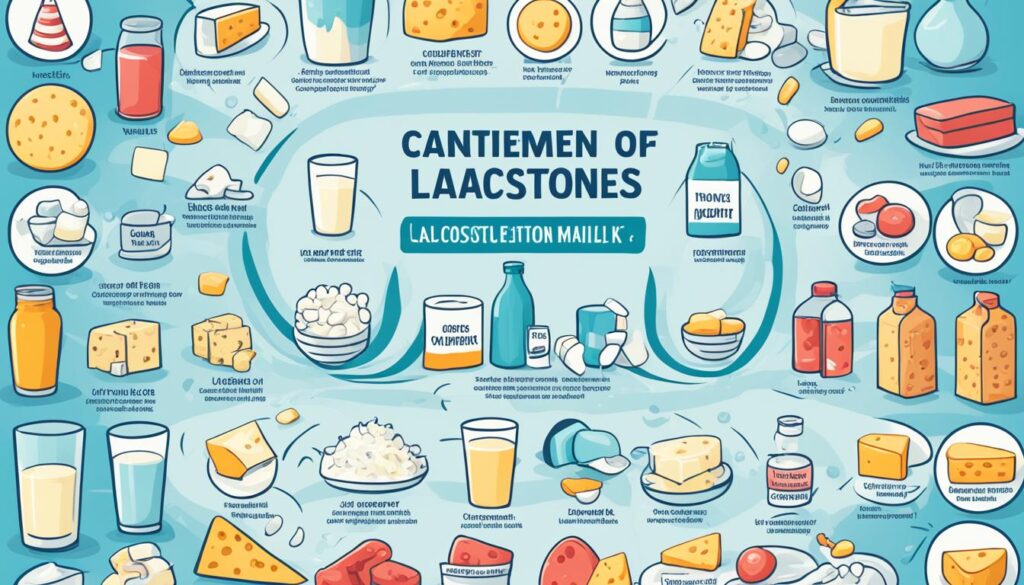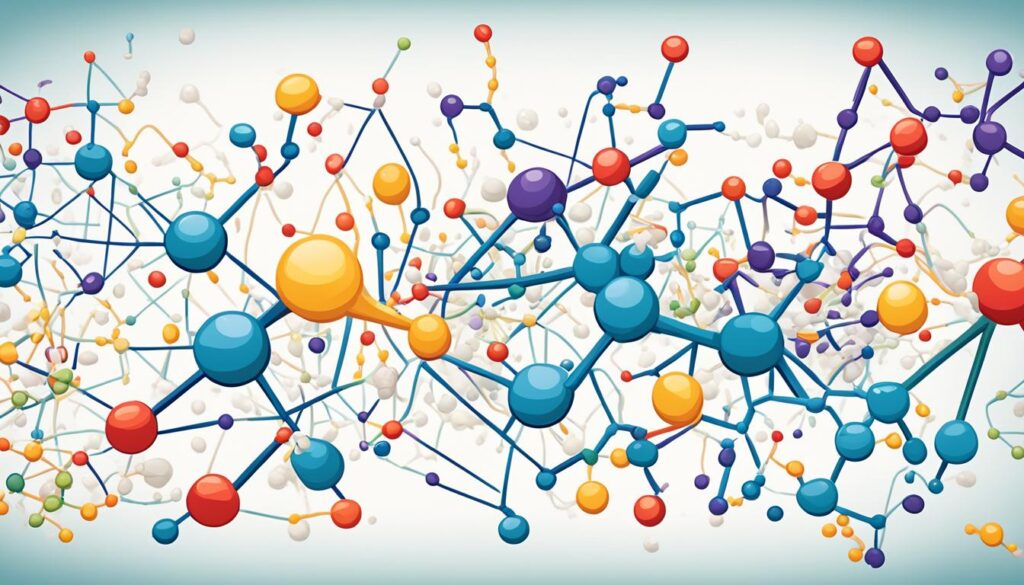Do you face bloating, diarrhea, or stomach issues after eating dairy? You might have lactose malabsorption. This happens when your body can’t make enough lactase, an enzyme needed to digest dairy.
Table of Contents
ToggleSymptoms of lactose intolerance include bloating, diarrhea, and stomach cramps. When your body can’t break down lactose well, it moves to the large intestine. There, it meets bacteria, causing these issues.
Understanding and dealing with lactose malabsorption symptoms can bring comfort. Learning about causes and triggers is key. This knowledge can help you manage the condition better for a happier, healthier life.
Understanding Lactose Intolerance
What Is Lactose Intolerance?
Lactose intolerance is common. It happens when the small intestine lacks enough of the lactase enzyme. This enzyme is needed to digest the lactose sugar in milk and dairy products.
Because of this, people with this condition can’t fully digest lactose. This issue is called lactose malabsorption. It causes various symptoms that are unpleasant.
The Role of Lactase Enzyme
The lactase enzyme normally breaks down milk sugar into easier forms. Glucose and galactose can then be easily absorbed into your blood. But, for those with lactose intolerance, this process doesn’t work well.
The undigested lactose goes to the colon. There, it reacts with bacteria, leading to the symptoms of lactose malabsorption.
Common Lactose Malabsorption Symptoms
Feeling bad after eating dairy? You might have lactose malabsorption. You could get bloated, have gas, diarrhea, or tummy cramps. Nausea and vomiting are also possible signs you have this condition.
These symptoms often show up a few hours after you eat something with lactose. Lactose is the sugar in milk and dairy. It might make you really uncomfortable for a while.
Bloating and Gas
Feeling gassy and bloated is common if you can’t digest lactose. Your body’s reaction to undigested lactose is to produce more gas and fluid. This can lead to a swollen belly and aches or pains.
Diarrhea
Diarrhea is a clear sign of lactose malabsorption. The undigested lactose in your gut draws in more water. This extra water leads to loose, watery stools and the urge to use the bathroom a lot.
Abdominal Cramps
The gas and fluid caused by lactose malabsorption can make your tummy hurt. These cramps might feel sharp and be in one spot or spread out. It can vary from a mild ache to being very painful.
Nausea and Vomiting
Feeling sick or throwing up after dairy? Lactose malabsorption could be why. Your body might not like the undigested lactose. It can make you really uncomfortable or worse, make you vomit.
Have these symptoms? You should talk to a doctor. They can help figure out what’s wrong and how to deal with it.

Lactose Malabsorption Symptoms Timing
If you struggle with lactose intolerance, knowing when your symptoms might start is vital. Symptoms usually show up 30 minutes to 2 hours after having dairy. This happens because your body can’t break down lactose well. So, it moves to the large intestine where bacteria interact with it. This is what causes symptoms like diarrhea, nausea, and bloating.
When Symptoms Appear
Symptoms of lactose intolerance can pop up at different times. Often, it’s within a few hours after you’ve had dairy. It takes from 6 to 10 hours for food to get to your large intestine. Then, food takes another 24-36 hours to travel through. This means you might still feel sick a day or two after eating or drinking dairy.
Duration of Symptoms
The time your symptoms last can change. But usually, they go away within a day or two of eating dairy. Remember, not everyone has these issues all the time. Lactose intolerance is more likely to happen as we get older. Young children and babies, however, are less likely to have it.
Foods That Trigger Lactose Intolerance
If you can’t handle lactose, avoid foods that set off your symptoms. Lactose is in milk and dairy. It causes trouble for those with lactose intolerance.
Dairy Products High in Lactose
Milk, cream, and fresh dairy items are loaded with lactose. Yogurt and cottage cheese are examples. They can be hard for you to digest if you’re lactose intolerant. However, hard cheeses are usually easier on the stomach.
Hidden Sources of Lactose
Lactose hides in processed foods like soups and salad dressings. Even some snacks have it. Also, some medications contain lactose as an inactive part. Always check for these hidden sources of lactose to avoid your symptoms.

Causes of Lactose Intolerance
The main cause of lactose intolerance is the lack of lactase enzyme. This lack makes it hard to digest lactose in the small intestine. Two main elements lead to lactose intolerance: not enough lactase and a sensitive gut. When you can’t digest lactose, you get symptoms because it moves to the large intestine.
Alongside the lack of lactase, many reasons can cause lactose intolerance. This includes genetic factors and certain health issues that affect the small intestine. Even being born premature or getting specific cancer treatments can stop the intestine from producing enough lactase. Your age, genetic background, and health conditions could also affect how lactose intolerance develops.
Types of Lactose Intolerance
Lactose intolerance comes in different forms. Each type has its own causes and traits. Research shows four main types: primary, secondary, congenital, and developmental.
Primary Lactose Intolerance
Primary intolerance affects most adults globally. It happens as the body makes less lactase with age. Without enough lactase, the body can’t digest dairy sugars properly.
Secondary Lactose Intolerance
Secondary intolerance can start suddenly. It’s usually after an injury or illness damages the small intestine. Things like surgery or conditions including celiac and Crohn’s disease can lead to this. They affect the production of lactase, causing problems with digesting lactose.
Congenital Lactose Intolerance
Congenital intolerance is a rare, genetic issue from birth. Individuals with this type lack the enzyme lactase from the start. Because of this, they can’t digest lactose properly. This condition is passed down by autosomal recessive genes.
Developmental Lactose Intolerance
Developmental intolerance is linked to being born early. Premature infants may have less cells for producing lactase. This causes a temporary issue with lactose digestion. Over time, as the small intestine grows, this problem often goes away.

Lactose Malabsorption Symptoms
If you have trouble with lactose, you might feel bloated, have diarrhea, or feel gassy. You could also be nauseous, have stomach pain, and hear noises from your stomach. These signs are common with lactose issues. They happen when your body can’t break down lactose all the way. Then, bacteria in your gut start a process that makes too much fluid and gas.
Doctors say if you have a problem with lactose, your symptoms might not show up right away. They can take a few hours to appear. This happens because it takes time for the undigested lactose to move through your gut to where it makes you feel sick.
The badness of your lactose problems can change. Maybe you feel a little sick after having some milk, or you really feel awful. It all depends on how much lactose you eat or drink, how sensitive your stomach and gut is, and your general health.
If you think you might have lactose issues, it’s a good idea to see a doctor. They can test you to find out if lactose is the problem. Then, they can help you make a plan to feel better by avoiding or managing lactose.
Genetic Factors in Lactose Intolerance
Your genes have a big say in if you’ll have lactose intolerance. Certain groups are more at risk because of their background. They might have a lot or very few lactase persistence genes.
Ethnicity and Lactose Intolerance
If you’re from Asian, Native American, Hispanic, or African origins, you might have trouble with dairy. Research says almost everyone in these groups slows down on making the lactase enzyme as they grow up. This can lead to having difficulty digesting lactose.
But, if your roots are in places that have used milk a lot, like Northern Europe, parts of Africa, and the Middle East, you’re in luck. You’re more likely to keep making lactase as an adult thanks to a special genetic ability known as lactase persistence.
Lactase Persistence Genes
A key gene, MCM6, helps some people digest milk sugar all their life. If you inherit the right changes in this gene, you might keep making lactase and avoid lactose intolerance.
But, some people miss out on making lactase right from the start. This happens due to rare genetic issues, leading to congenital lactase deficiency. It means they’re lactose intolerant from birth because their bodies can’t make the necessary enzyme.

Developing Lactose Intolerance Over Time
As you grow older, your body might make less of the lactase enzyme. This leads to a condition called lactose intolerance over time. About 65% of people worldwide experience this type of lactose intolerance.
Where you come from can also influence your chances of developing lactose intolerance. People from Asia, Native America, and Hispanic heritages might have a higher risk. Folks with roots in Northern Europe, Africa, and the Middle East, however, might keep making lactase into adulthood.
Lactose intolerance isn’t common in young kids but can show up more as you get older. If your body makes less lactase, you might feel bloated or gassy after eating dairy. This leads to symptoms like bloating, gas, diarrhea, and stomach pains.
The timeline for developing lactose intolerance can vary a lot. Some people see a slow decrease in lactase, while others might notice a sudden change. Things like being born early, certain health problems, and treatments can affect how this happens.
If you think you might be getting lactose intolerance, talking to a doctor is key. They can help you find out and suggest ways to deal. With the right diet and maybe some supplements, you can often keep enjoying dairy and stay healthy.
Sudden Onset of Lactose Intolerance
Many people find out they are lactose intolerant slowly over time. But, some can suddenly feel the symptoms. This is called secondary lactose intolerance. It happens when things affect the speed at which your small intestine works.
Secondary Causes of Sudden Lactose Intolerance
Experts say that a sudden drop in the ability to digest lactose is often because of small intestine damage. This can be from injuries, operations, infections, or certain health issues. These problems stop the small intestine from making enough lactase, which plays a vital role in digesting lactose.
This change in sudden onset of lactose intolerance doesn’t mean it’s over forever. When the small intestine heals and starts working better, some people go back to tolerating lactose. It’s key to team up with a healthcare expert to manage your diet during this recovery.
If you had no trouble with dairy before, these sudden changes can be quite surprising. Issues that harm the small intestine can bring about lactose malabsorption. This leads to symptoms like bloating, gas, trouble in the bathroom, and tummy pains.

Lactose Intolerance vs. Milk Allergy
Digestive problems with dairy can be tough. It’s crucial to know the difference between lactose intolerance and a milk allergy. They both lead to symptoms but are caused by different things.
Lactose intolerance happens when your body can’t break down milk sugar well. This comes from not having enough of the enzyme lactase. The undigested sugar goes to your colon, where it meets bacteria, causing issues like bloating and diarrhea.
A milk allergy means your body’s defense system reacts badly to milk proteins. If someone allergic eats dairy, it sets off an immune response. This can bring on serious symptoms, from hives to trouble breathing and even be life-threatening.
utton>Click here to see a visually engaging infographic comparing lactose intolerance and milk allergy.
These issues often show up at different times. Babies can have milk allergies early on. But lactose intolerance might not pop up until later in life. You can help lactose intolerance with diet changes and supplements. Yet, for a milk allergy, avoiding all dairy is the only safe way.
Knowing these differences is key for getting the right help. If eating dairy always makes you feel bad, see a doctor. They can figure out what’s really going on and help you manage it.
Diagnosing Lactose Malabsorption
Think you might have trouble with dairy? Finding out is key. One solid method is trying an elimination diet. You stop eating dairy for a while to check if your symptoms go away. If they do, lactose could be the problem.
Elimination Diet
With an elimination diet, you cut out dairy for a few weeks. If you start feeling better, it’s likely lactose causing your issue. After that break, you add dairy back slowly. It shows which dairy hurts you.
Hydrogen Breath Test
The hydrogen breath test is another way to check for lactose issues. You drink something with lactose and then blow into a device. High hydrogen means your body isn’t handling lactose well, pointing to lactose intolerance.
Both methods help pinpoint lactose malabsorption. Knowing for sure means you can make dietary changes to deal with it. You can cut out the right foods to feel better and still eat healthy.

Managing Lactose Intolerance
If you’re diagnosed with lactose intolerance, there are ways to cope and still eat well. Eating smart, taking a supplement, and trying probiotics can help manage the discomfort.
Dietary Modifications
A big step in handling lactose intolerance is changing what you eat. Cut back on high-lactose foods like milk, cream, and soft cheeses. Yet, some dairy like cheddar, Swiss, and yogurt are usually fine.
Tip: Watch how much dairy you eat. Small portions might sit better. You can also go for lactose-free options or take a supplement to help digest dairy.
Lactase Supplements
Lactase enzyme pills are another way to deal with lactose intolerance. They help break down the lactose in dairy foods. Taking one before eating dairy can make a big difference.
It’s key to use the supplements correctly. Following the product’s instructions or talking to your doctor is wise. For some, taking it with the first bite helps the most.
Probiotics for Lactose Intolerance
Adding probiotics to your diet might also improve things. These good bacteria can help digest lactose better. Foods like yogurt and kefir, or a probiotic supplement, could be beneficial.
Certain types of bacteria, like Bifidobacterium and Lactobacillus, work better for lactose intolerance.
Using a mix of diet, supplements, and probiotics can make living with lactose intolerance easier. Working with your doctor is vital for a plan that suits you.
Conclusion
Lactose malabsorption and intolerance can make you feel uncomfortable. They cause bloating, gas, diarrhea, and stomach cramps. This happens after eating or drinking things with lactose, like milk. It happens because your body doesn’t have enough of a key enzyme to digest lactose.
There are different types of lactose intolerance. They can be genetic or happen because of an illness or injury to the stomach. Changing what you eat, taking supplements, and using probiotics can help. But, it’s best to see a doctor to figure out the best way to manage it.
Knowing the signs and reasons behind lactose intolerance is key. With the right help and by making smart choices, you can deal with lactose intolerance. This way, you can live without the discomfort that lactose can cause.
FAQ
What are the signs and symptoms of lactose intolerance?
Lactose intolerance can cause bloating, gas, diarrhea, and stomach cramps. When you can’t properly digest lactose, the sugar in milk and dairy, it leads to these issues.
What causes lactose intolerance?
The small intestine not making enough lactase causes the issue. Lactase usually makes lactose into simpler sugars our body uses. When this doesn’t happen, problems like gas and bloating occur.
What are the most common symptoms of lactose intolerance?
Common symptoms include bloating, gas, diarrhea, and stomach cramps. This happens when undigested lactose moves to the colon and interacts with bacteria there.
When do the symptoms of lactose intolerance typically appear?
Usually, they start 30 minutes to 2 hours after eating or drinking something with lactose. But sometimes, symptoms might not show up for up to a day or two later.
What foods and drinks contain lactose?
Most dairy foods like milk and cheese contain lactose. Some processed foods also have it, like soups and salad dressings.
What causes lactose intolerance?
Lactose intolerance comes from not having enough lactase in the small intestine. This leads to issues when digesting lactose. Usually, this lack of lactase is due to genetics.
What are the different types of lactose intolerance?
There are four types: primary, secondary, congenital, and developmental. Primary is common and happens as people age. Secondary is due to illness. Congenital is rare and happens from birth. Developmental happens in premature babies, where the intestine is not fully developed.
What are the key symptoms of lactose malabsorption?
Signs include bloating, diarrhea, gas, nausea, and stomach pain. These happen when lactose isn’t digested and reaches the colon, where bacteria reacts with it.
How do genetic factors influence lactose intolerance?
Genes greatly affect who gets lactose intolerance. Some ancestry groups have a higher risk. Northern Europeans are more likely to digest lactose well because they have the gene for lactase persistence.
How does lactose intolerance develop over time?
Lactose intolerance can start in childhood or later in life as the body makes less lactase. Over time, people’s ability to digest lactose may decrease, leading to symptoms.
Can lactose intolerance develop suddenly?
Yes, an issue with the small intestine can cause sudden lactose intolerance. This can happen from things like injury or disease. In some cases, this form of intolerance may not last forever.
How is lactose intolerance diagnosed?
To know for sure, some doctors suggest removing dairy from your diet for a while. There’s also a breath test that can measure how well you digest lactose.
How can lactose intolerance be managed?
Managing it usually involves changing your diet or taking supplements to help with digestion. Probiotics can also be beneficial in managing the condition.
Source Links
- https://my.clevelandclinic.org/health/diseases/7317-lactose-intolerance
- https://www.mayoclinic.org/diseases-conditions/lactose-intolerance/symptoms-causes/syc-20374232
- https://www.niddk.nih.gov/health-information/digestive-diseases/lactose-intolerance/symptoms-causes
- https://www.ncbi.nlm.nih.gov/pmc/articles/PMC4040760/
- https://www.hopkinsmedicine.org/health/conditions-and-diseases/lactose-intolerance
- https://www.webmd.com/digestive-disorders/digestive-diseases-lactose-intolerance
- https://medlineplus.gov/genetics/condition/lactose-intolerance/
- https://www.ncbi.nlm.nih.gov/pmc/articles/PMC8838180/


